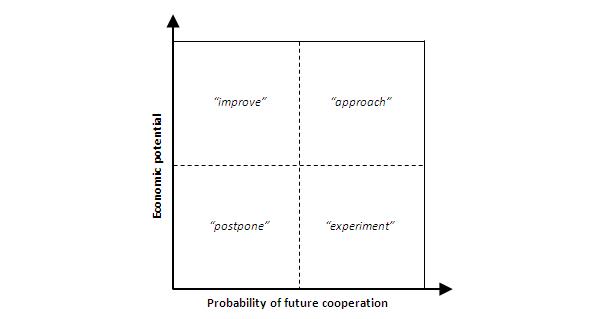A four-step methodology in structuring payer landscapes in volatile environments

Dr Rainer Opgen-Rhein, Giorgia Leoni and Hassan Bruneo
Simon-Kucher &, Partners
Dr Rainer Opgen-Rhein, Giorgia Leoni and Hassan Bruneo share their development of a four-step methodology that allows pharmaceutical companies to structure their payer landscapes in rapidly changing environments.
Current financial restrictions in most of the biggest economies have effects also in the national healthcare systems, creating new challenges for pharmaceutical companies.
These organizations increasingly need guidance in identifying and approaching key stakeholders. This need is exacerbated by the inconsistency within and across payer landscapes.
The following four-stage heuristic approach allows an organization to structure information about a heterogeneous stakeholder class, to develop effective targeted strategies, and to integrate all data and results into a comprehensive tool. Pharmaceutical companies can thus confidently and efficiently allocate resources based on structured evidence derived from both external and internal sources.
Such methodology (called “prioritization”) allows for both the identification of stakeholders that might be especially interesting for future cooperation, and development of targeting strategies.
 ,
"Pharmaceutical companies can thus confidently and efficiently allocate resources based on structured evidence derived from both external and internal sources."
 ,
1. Data aggregation: structure a database
To identify stakeholders of interest, all available data from different sources and types (often publicly accessible) could be collected, e.g., characteristics of various stakeholder institutions, including:
• The population covered (in terms of size, distribution over cohorts, etc…)
• The financial strength, budget, or buying power
• Past behavior in terms of contracting or formulary policies
The database can integrate not only quantitative but also qualitative data, if it is structured using characteristics previously defined. When assembling information for the database, privacy protection must be accounted for and users should ensure that measures are taken to follow the relevant privacy protection rules.
2. Prioritization
Once the database is built, its data is aggregated and structured in response to the main questions of interest, i.e. the probability for future cooperation and / or the economic potential of a given stakeholder. All information is mapped onto these two dimensions (see figure 1).
A heuristic approach defines a proxy for the past-experience-dependent method outlined previously. Using weights, several criteria are condensed into single scores for each dimension:
i. Adapt and allocate the quantitative and qualitative information available in the database to the two dimensions previously outlined, that is, probability of future cooperation and the stakeholder’s economic potential.
ii. Whenever the database is now queried, use a brief initial analysis to determine which information in the database is useful and which can be discounted for that specific query. Define weights for each criterion to best reflect their importance and relevance for the respective dimension. The weighting values remain modifiable as different problems in day-to-day work might require adjustment. For example, the pharmaceutical company might want to assess the willingness of stakeholders to negotiate future contracts in a certain disease area, therefore, criteria closely connected to this indication might receive higher weighting.
 ,
"...it’s possible to extrapolate specific actions and develop suitable targeting strategies."
 ,
iii. Lastly, sum up the points derived from each criterion area and calculate two index numbers for each stakeholder representing each dimension.
Stakeholders can now be positioned in a two-dimensional graph with “probability of future cooperation" located on the x-axis while "economic potential" is on the y-axis.
In the final prioritization stage, different stakeholder clusters are defined based on the similarities of their position within the grid. This reduces the complexity of the information and allows simplification of the next part of the approach. Within the outcome graphic that summarizes the attractiveness of each stakeholder, it’s possible to extrapolate specific actions and develop suitable targeting strategies.
3. Develop targeting strategies
The position of stakeholders within the graph already suggests possible strategies for their prioritization and ways to approach them:
Figure 1: Prioritization matrix
• Approach (top right segment): Stakeholders here have high economic potential and opportunities for possible cooperation seem favorable. These should be prioritized for future cooperation.
• Improve (top left segment): While economic potential is advantageous, possibilities for future cooperation are limited based on the existing quantitative data and qualitative experience. The challenge lies in facilitating cooperation and negotiation with stakeholders that also allows the pharmaceutical companies to reach their goals. Successful examples provided by agreements or past cooperation with stakeholders from the “approach” segment might provide a lever to tackle these stakeholders.
• Experiment (bottom right segment): These stakeholders might be willing to cooperate or negotiate. However, their economic potential is lower. This makes it both less attractive for the pharmaceutical company to invest time and effort into building a relationship with these stakeholders, and might also limit available stakeholder resources to invest in cooperation or negotiations. Experimenting with new contracting models like standardized offers could help to overcome these hurdles and extract some value from such stakeholders.
• Postpone (bottom left segment): As their economic potential and willingness to cooperate is lower compared to the other segments, companies should give these stakeholders the lowest priority for seeking negotiations or agreements. Nevertheless, as stakeholder positions in the graph could shift eventually, monitoring should continue to capture interesting changes.
Finally, specific data available, via the database created in step one, allows the development of detailed recommendations for individual stakeholders.
4. Knowledge base
All data, information and recommendations from previous steps can be integrated into a single knowledge base. The underlying data, and the weights placed upon each criterion are editable. This option is vital in rapidly changing environments, where calculations regarding positioning of stakeholders along the dimensions of "economic potential" and "possibility for future cooperation" are performed in real-time.
 ,
"All data, information and recommendations from previous steps can be integrated into a single knowledge base."
 ,
The value of this knowledge base on a daily basis can be established. The model provides:
• The ability to inspect data relating to individual stakeholders.
• The opportunity to filter stakeholders according to specific criteria.
• Visualization of the results of prioritization.
• A targeting strategy at both individual and cluster-specific levels.
Conclusion
A comprehensive and easy-to-use database integrates all existing information into a single tool. This tool can be particularly useful in allowing a company’s field forces to base decisions on evidence rather than mere instinct. In addition, the possibility of updating the underlying data and the calculations behind the prioritization, plus the recommendations for targeted approaches in real-time ensures that the tool provides longevity for the pharmaceutical company – even in rapidly changing environments.
About the authors:
Dr Rainer Opgen-Rhein
Dr Rainer Opgen-Rhein is a senior consultant with the Munich office of the Life Sciences Division of Simon-Kucher and Partners. He can be contacted on: Rainer.Opgen-Rhein@simon-kucher.com.
Giorgia Leoni
Giorgia Leoni is a consultant with the Milan office of the Life Sciences Division of Simon-Kucher &, Partners. She can be contacted on: giorgia.leoni@simon-kucher.com.
Hassan Bruneo
Hassan Bruneo is a consultant with Milan office of the Life Sciences Division of Simon-Kucher &, Partners. He can be contacted on: Hassan.bruneo@simon-kucher.com.
Simon-Kucher &, Partners is a global consulting firm with 585 professionals in 23 offices worldwide focusing on Smart Profit GrowthSM. Founded in 1985, the company has over 25 years of experience providing strategy and marketing consulting, and is regarded as the world’s leading pricing advisor.
How can pharmaceutical companies better approach relevant payers?












